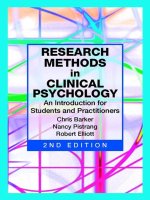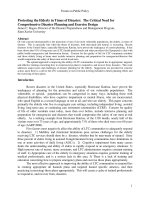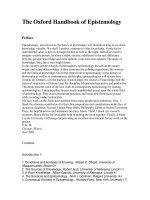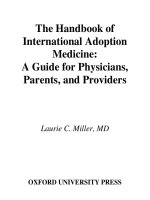Oxford Handbook of Clinical Dentistry (6e 2014)
Bạn đang xem bản rút gọn của tài liệu. Xem và tải ngay bản đầy đủ của tài liệu tại đây (24.44 MB, 813 trang )
OXFORD MEDICAL PUBLICATIONS
Oxford Handbook of
Clinical Dentistry
Published and forthcoming Oxford Handbooks
Oxford Handbook for the Foundation
Programme 4e
Oxford Handbook of Acute
Medicine 3e
Oxford Handbook of Anaesthesia 3e
Oxford Handbook of Applied Dental
Sciences
Oxford Handbook of Cardiology 2e
Oxford Handbook of Clinical and
Laboratory Investigation 3e
Oxford Handbook of Clinical
Dentistry 6e
Oxford Handbook of Clinical
Diagnosis 3e
Oxford Handbook of Clinical
Examination and Practical Skills 2e
Oxford Handbook of Clinical
Haematology 3e
Oxford Handbook of Clinical
Immunology and Allergy 3e
Oxford Handbook of Clinical
Medicine – Mini Edition 8e
Oxford Handbook of Clinical
Medicine 9e
Oxford Handbook of Clinical
Pathology
Oxford Handbook of Clinical
Pharmacy 2e
Oxford Handbook of Clinical
Rehabilitation 2e
Oxford Handbook of Clinical
Specialties 9e
Oxford Handbook of Clinical
Surgery 4e
Oxford Handbook of Complementary
Medicine
Oxford Handbook of Critical Care 3e
Oxford Handbook of Dental
Patient Care
Oxford Handbook of Dialysis 3e
Oxford Handbook of Emergency
Medicine 4e
Oxford Handbook of Endocrinology
and Diabetes 3e
Oxford Handbook of ENT and Head
and Neck Surgery 2e
Oxford Handbook of Epidemiology for
Clinicians
Oxford Handbook of Expedition and
Wilderness Medicine
Oxford Handbook of Forensic
Medicine
Oxford Handbook of
Gastroenterology & Hepatology 2e
Oxford Handbook of General
Practice 4e
Oxford Handbook of Genetics
Oxford Handbook of Genitourinary
Medicine, HIV and AIDS 2e
Oxford Handbook of Geriatric
Medicine 2e
Oxford Handbook of Infectious
Diseases and Microbiology
Oxford Handbook of Key Clinical
Evidence
Oxford Handbook of Medical
Dermatology
Oxford Handbook of Medical Imaging
Oxford Handbook of Medical
Sciences 2e
Oxford Handbook of Medical Statistics
Oxford Handbook of Neonatology
Oxford Handbook of Nephrology and
Hypertension 2e
Oxford Handbook of Neurology 2e
Oxford Handbook of Nutrition and
Dietetics 2e
Oxford Handbook of Obstetrics and
Gynaecology 3e
Oxford Handbook of Occupational
Health 2e
Oxford Handbook of Oncology 3e
Oxford Handbook of
Ophthalmology 3e
Oxford Handbook of Oral and
Maxillofacial Surgery
Oxford Handbook of Orthopaedics
and Trauma
Oxford Handbook of Paediatrics 2e
Oxford Handbook of Pain
Management
Oxford Handbook of Palliative Care 2e
Oxford Handbook of Practical Drug
Therapy 2e
Oxford Handbook of
Pre-Hospital Care
Oxford Handbook of Psychiatry 3e
Oxford Handbook of Public Health
Practice 3e
Oxford Handbook of Reproductive
Medicine & Family Planning 2e
Oxford Handbook of Respiratory
Medicine 3e
Oxford Handbook of
Rheumatology 3e
Oxford Handbook of Sport and
Exercise Medicine 2e
Handbook of Surgical Consent
Oxford Handbook of Tropical
Medicine 4e
Oxford Handbook of Urology 3e
Oxford Handbook of
Clinical
Dentistry
Sixth edition
David A. Mitchell
and
Laura Mitchell
with contributions from
Lorna McCaul
1
3
Great Clarendon Street, Oxford, OX2 6DP,
United Kingdom
Oxford University Press is a department of the University of Oxford.
It furthers the University’s objective of excellence in research, scholarship,
and education by publishing worldwide. Oxford is a registered trade mark of
Oxford University Press in the UK and in certain other countries
© David A. and Laura Mitchell, 99, 995, 999, 2005, 2009, 204
The moral rights of the authorshave been asserted
First published 99
Second edition published 995
Third edition published 999
Fourth edition published 2005
Fifth edition published 2009
Sixth edition published 204
Impression:
All rights reserved. No part of this publication may be reproduced, stored in
a retrieval system, or transmitted, in any form or by any means, without the
prior permission in writing of Oxford University Press, or as expressly permitted
by law, by licence or under terms agreed with the appropriate reprographics
rights organization. Enquiries concerning reproduction outside the scope of the
above should be sent to the Rights Department, Oxford University Press, at the
address above
You must not circulate this work in any other form
and you must impose this same condition on any acquirer
Published in the United States of America by Oxford University Press
98 Madison Avenue, New York, NY 006, United States of America
British Library Cataloguing in Publication Data
Data available
Library of Congress Control Number: 204930095
ISBN 978–0–9–967985–0
Printed in China by
C&C Offset Printing Co. Ltd
Oxford University Press makes no representation, express or implied, that the
drug dosages in this book are correct. Readers must therefore always check
the product information and clinical procedures with the most up-to-date
published product information and data sheets provided by the manufacturers
and the most recent codes of conduct and safety regulations. The authors and
the publishers do not accept responsibility or legal liability for any errors in the
text or for the misuse or misapplication of material in this work. Except where
otherwise stated, drug dosages and recommendations are for the non-pregnant
adult who is not breast-feeding.
Links to third party websites are provided by Oxford in good faith and
for information only. Oxford disclaims any responsibility for the materials
contained in any third party website referenced in this work.
v
Preface to the
first edition
Dental students are introduced to real live patients at an early stage of
their undergraduate course in order to fulfil the requirements for clinical
training, with the result that they are expected to absorb a large quantity of
information in a relatively short time. This is often compounded by clinical
allocations to different specialities on different days, or even the same day.
Given the obvious success of the Oxford handbooks of clinical medicine
and clinical specialities, evidenced by their position in the white coat pockets
of the nation’s medical students, the extension of the same format to dentistry seems logical. However, it is hoped that the usefulness of this idea will
not cease on graduation, particularly with the introduction of Vocational
Training. While providing a handy reference for the recently qualified graduate, it is envisaged that trainers will also welcome an aide mémoire to help
cope with the enthusiastic young trainee who may be more familiar with
recent innovations and obscure facts. We also hope that there will be much
of value for the hospital trainee struggling towards FDS.
The Oxford Handbook of Clinical Dentistry contains those useful facts and
practical tips that were stored in our white coat pockets as students and
then postgraduates; initially on scraps of paper, but as the collection grew,
transferred into notebooks to give a readily available reference source.
The dental literature already contains a great number of erudite books
which, for the most part deal exclusively, in some depth, with a particular
branch or aspect of dentistry. The aim of this handbook is not to replace
these specialist dental texts, but rather to complement them by distilling
together theory and practical information into a more accessible format.
In fact, reference is made to sources of further reading where necessary.
Although the authors of this handbook are not the specialized authorities
usually associated with dental textbooks, we are still near enough to the
coal-face to provide, we hope, some useful practical tips based on sound
theory. We were fortunate whilst compiling this handbook in being able to
draw on the expertise of many colleagues; the contents, however, remain
our sole responsibility. The format of a blank page opposite each page of
text has been plagiarized from the other Oxford handbooks. This gives
space for the reader to add his own comments and updates. Please let us
know of any that should be made available to a wider audience.
We hope that the reader will find this book to be a useful addition to their
white coat pocket or a companion to the BNF in the surgery.
vi
Preface to the
second edition
It would appear that our ‘baby’ is now a toddler and rapidly outgrowing
his previous milieu. Caring for such a precocious child is hard work and
therefore we have again relied on the help of understanding friends and colleagues who have contributed their knowledge and expertise.
The pace of change in dentistry, both scientifically and politically, is so
fast that although the first edition was only published in 99, this second
edition has involved extensive revision of all chapters. Advances in dental
materials and restorative techniques have necessitated major revision of
these sections and we are indebted to Mr Andrew Hall, who has helped
update the chapter on restorative dentistry.
Since the first edition was published, political changes in the UK have
resulted in a shift towards private dentistry. This changing emphasis is
reflected in the practice management chapter, which now includes a new
page on independent and private practice. In addition recent developments
in cross-infection control and UK health and safety law have been included.
That old favourite, temporomandibular pain dysfunction syndrome,
has also been given the treatment and is now situated on a newly devised
page in the chapter on oral medicine. Non-accidental injury, guided tissue
regeneration, AIDS, ATLS, and numerous other topical issues have been
expanded in this edition.
One aspect of this developing infant remains, however, unchanged. The
sole purpose of this book is to enable you, the reader, to gain easy access
to the sometimes confusing conglomerate of facts, ideas, opinions, dogma,
anecdote, and truth that constitutes clinical dentistry. To this framework
you should add, on the blank pages provided, the additional information
which will help you treat the next patient or pass the next exam, or more
importantly the practical hints and tips which you will glean with experience.
It is the potential for that interaction which makes this book distinctive in
clinical dentistry. It is participating in that interaction which makes your book
unique.
vii
Preface to the
third edition
Like any proud parents we are surprised and delighted with the continued development of our ‘baby’, and we are grateful to all those who have
helped or provided positive feedback. We are also grateful to our colleagues who have helped with the ‘baby-care’.
Of course, now being of school age, peer group rivalry has arrived, but
ours is a robust child and despite being the first kid on the block welcomes
both competition and change.
Some of this change is reflected by bringing in a new contributor who
has overseen a complete overhaul of the restorative dentistry chapters and
a large number of new contributions to reflect dentistry in the late 990s.
Our own areas of (increasingly erudite) specialist expertise have grown
apace but we think we have curbed the temptation to dwell on these in
what is, after all, a generalist text for the earlier years; we trust the odd
excursion will be forgiven.
We hope that the new sections, which include: evidence-based medicine/dentistry; the new NHS complaints procedure, objective structured
clinical examinations, the 997 Advanced Life Support Guidelines, and the
completely revised restorative chapters will prove helpful and informative.
We would, however, like to remind you that the blank pages are there for
your additional notes—and it is this that makes your copy of this Handbook
unique. Please do not hesitate to share these annotations with us, we would
be happy to include the best we receive in the next edition and to acknowledge the contributor.
As always while we are grateful for the contributions of our colleagues
the contents and the brickbats remain our sole responsibility.
viii
Preface to the
fourth edition
A new millennium means new technology and new challenges.
So the time has come to update the Oxford Handbook of Clinical Dentistry.
In fact the pace of change is such that all chapters in this new edition have
been completely revised. To continue the analogy of earlier prefaces: our
teenager is keen on exploring new avenues, so we are going to indulge this
by expanding our horizons into new attitudes and technology with a section
on Dentistry and the World Wide Web, and also a section on web-based
learning. This new, twenty-first century edition has the added bonus of colour plates and more diagrams to aid understanding.
We are, as ever, indebted to contributors past and present. The new
recruits bring both knowledge and enthusiasm to their areas of expertise as
well as to the book as a whole, and build on the work of previous contributors. To all we are greatly indebted. The ultimate responsibility for errors or
oversights remains, as always, ours.
Please keep sending us feedback—this is the best way for us to improve
future editions.
Let’s just hope the teenager doesn’t rebel!!
Preface to the
fifth edition
The first draft of this book was started in 989, the year the Berlin wall
came down and the first edition appeared in 99 making our ‘child’ legal
by this, the fifth, edition.
As an eighteenth birthday present this edition includes, as well as the
usual extensive rewrite and update of the text, a substantial improvement in
the quality of the illustrations, which are now in colour and integrated into
the text. This will mean less space for making your own notes in the blank
pages but we suspect you will be willing to make the trade-off.
In keeping with previous practice new contributors have been included
in order to ensure the material is as up to date as possible and we have
tried to avoid overemphasizing our current areas of sub-specialization. As
before, this book is the sum of its previous incarnations helped by feedback
from readers from all parts of the world and the input of contributors. As
always, responsibility for any errors or omissions lies with us.
ix
Preface to the
sixth edition
By the time this, the sixth edition of the Oxford Handbook of Clinical
Dentistry reaches the shelves or the app on your smartphone it will have
celebrated its 2st birthday. Now a mature adult it has, for the moment,
declined to leave home and despite its experience and worldly wise nature
has certain hankerings towards younger, simpler days. For this reason along
with the usual extensive updates and rewrites we want to re-emphasize the
interactive nature of this book by encouraging you to personalize your copy
using the blank ‘noteboxes’ where you create your version by augmenting
or perhaps even correcting the content in light of your reading (and if you
do, let us know the details for future editions, please don’t just make vague
comments on an Internet review site) or more importantly your personal
clinical experience.
x
Acknowledgements
In addition to those readers whose comments and suggestions have been
incorporated into the sixth edition, we would like to thank the following
for their time and expertise in updating individual chapters: Mr S. Fayle, Mr
A. Graham, Dr H. Gorton, Ms E. McDerra, Dr I. McHenry, Dr L. Middlefell,
Mr L. Savarrio, Mr R. Singh KC, Ms J. Smith, Dr I. Suida, Ms Y. Shaw, Mr
I. Varley.
In addition, this book is the sum and distillate of its previous incarnations,
which would not have been possible without; Mr K. Abdel-Ghalil, Mr B. S.
Avery, Mr N. Barnard, Professor P. Brunton, Ms F. Carmichael, Mr N. E.
Carter, Mr P. Chambers, Mr M. Chan, Dr A. Dalghous, Mrs J. J. Davison,
Dr R. Dookun, Ms S. Dowsett, Dr C. Flynn, Dr H. Gorton, Dr I. D.
Grime, Mr A. Hall, Mr H. Harvie, Ms V. Hind, Ms J. Hoole, Dr J. Hunton,
Mr D. Jacobs, Mr W. Jones, Mr P. J. Knibbs, Ms K. Laidler, Mr C. Lloyd,
Mr M. Manogue, Professor J. F. McCabe, Dr L. Middlefell, Dr B. Nattress,
Mr R. A. Ord, Dr J. E. Paul, Mr J. Reid, Professor A. Rugg-Gunn, Professor
R. A. Seymour, Professor J. V. Soames, Ms A. Tugnait, Dr D. Wood, and
Professor R. Yemm. We acknowledge the hard work and expertise of
Katherine Grice, the medical artist responsible for improving our amateur
diagrams beyond recognition.
We are grateful to the editor of the BMJ, the BDJ and Professor M. Harris,
the Royal National Institute of the Deaf, Laerdal, and the Resuscitation
Council UK for granting permission to use their diagrams, and VUMAN for
allowing us to include the Index of Orthodontic Treatment Need.
Once again the staff of OUP deserve thanks for their help and
encouragement.
Note Although this is an equal opportunity publication, the constraints of
space have meant that in some places we have had to use ‘he’ or ‘their’ to
indicate ‘he/she’, ‘his/hers’, etc.
xi
Contents
Symbols and abbreviations
History and examination
2 Preventive and community dentistry
3 Paediatric dentistry
4Orthodontics
5 Restorative dentistry : periodontology
6 Restorative dentistry 2: repairing teeth
7 Restorative dentistry 3: replacing teeth
8 Restorative dentistry 4: endodontics
9 Oral surgery
0Oral medicine
Maxillofacial surgery
2Medicine relevant to dentistry
3Therapeutics
4Analgesia, anaesthesia, and sedation
5Dental materials
6Law and ethics
7Professionalism and communication
8Practice management
9Syndromes of the head and neck
20Useful information and addresses
Index
xii
23
55
9
7
27
263
325
35
407
463
503
575
603
627
667
689
73
75
76
779
xii
Symbols and abbreviations
Some of these are included because they are in common usage, others
because they are big words and we were trying to save space.
2
this is important
Ecross-reference
∆diagnosis
$supernumerary
–venegative
+vepositive
&/orand/or
iincreased
ddecreased
7approximately
#fracture
µ
micro (e.g. µm)
?
question/ask about (when ? appears alone)
∴therefore
°primary
2°secondary
3°tertiary
5; inc
lower second premolar, lower incisor
2; inc
upper lateral incisor, upper incisor
3-D
three dimensional
ACS
American College of Surgeons
ACTH
adrenocorticotrophic hormone
ADH
antidiuretic hormone
ADJ
amelo-dentinal junction
Agantigen
AIDS
acquired immune deficiency syndrome
ALS
advanced life support
AOB
anterior open bite
APantero-posterior
ARF
acute renal failure
ASAP
as soon as possible
ATLS
advanced trauma life support
SYMBOLS AND ABBREVIATIONS
BCC
basal cell carcinoma
bdtwice daily
BDA
British Dental Association
BDJ
British Dental Journal
BIPP
bismuth iodoform paraffin paste
BLS
basic life support
b/wbitewing
BMA
British Medical Association
BNF
British National Formulary
BP
blood pressure
BPE
Basic Periodontal Examination
BRON
bisphosphonate related osteonecrosis
BSS
black silk suture
Ca2+calcium
CAD/CAM computer-aided design/computer-aided manufacture
C&S
culture and sensitivity
CDS
Community Dental Service
C/IContraindication
Class IClass I relationship
Class II/
Class II division relationship
Class II/2
Class II division 2 relationship
Class III
Class III relationship
CLP
cleft lip and palate
cmcentimetre
CMVcytomegalovirus
CNS
central nervous system
C/Ocomplaining of
CPD
Continuing Professional Development
CPITN
Community Periodontal Index of Treatment Needs
CPR
cardiopulmonary resuscitation
CSFcerebrospinal fluid
CSM
Committee on Safety of Medicines
CT
computed tomography
CVA
cerebro-vascular accident
CXRchest X-ray
DCP
Dental Care Professional
dLdecilitre
DNdental nurse
DOH/DH Department of Health
DPF
Dental Practitioner’s Formulary
xiii
xiv
SYMBOLS AND ABBREVIATIONS
DPT
dental panoramic tomogram (politically correct: OPT/OPG)
DVT
deep venous thrombosis
EBA
ethoxy benzoic acid
EBM/D
evidence-based medicine/dentistry
EBVEpstein–Barr virus
ECC
early childhood caries
ECGelectrocardiograph
EDTA
ethylene diamine tetraacetic acid
e.g.
for example
EMD
enamel matrix derivative
EMLA
eutectic mix of lidocaine and prilocaine
ENT
ear, nose, and throat
EOextra-oral
ESR
erythrocyte sedimentation rate
EUA
examination under anaesthesia
Ffemale
F/-
full upper denture (and -/F for lower)
FA
fixed appliance
FABP
flat anterior bite plane
FBforeign body
FBC
full blood count
FESS
functional endoscopic sinus surgery
fLfemtolitre
FNAC
fine-needle aspiration cytology
f/s
fissure sealant
FWSfreeway space
ggram
GA
general anaesthesia
GAP
generalized aggressive periodontitis
GDC
General Dental Council
GDP
general dental practitioner
GDS
General Dental Services
GI
glass ionomer
GKI
glucose, potassium, insulin
GMP
general medical practitioner
GPgutta-percha
GTR
guided tissue regeneration
hhour
Hbhaemoglobin
HDU
high dependency unit
SYMBOLS AND ABBREVIATIONS
Hep B/C
hepatitis B/C
Hgmercury
HIV
human immunodeficiency virus
HLA
human leucocyte antigen
HPV
human papilloma virus
HRT
hormone replacement therapy
HSV
herpes simplex virus
ICP
intercuspal position
ICU
intensive care unit
IDinferior dental
IDB
inferior dental block
IDN
inferior dental nerve
i.e.that is
IE
infective endocarditis
Ig
immunoglobulin (e.g. IgA, IgG, etc.)
IMintramuscular
IMF
intermaxillary fixation
incincisor
INR
international normalized ratio
IOintra-oral
IOTN
Index of Orthodontic Treatment Need
IRM
Intermediate Restorative Material®
ITP
idiopathic thrombocytopenic purpura
IUinternational units
IVintravenous
K+potassium
KCT
kaolin–cephalin clotting time
kgkilogram
kVkilovolt
Llitre
LA
local anaesthesia
LAP
localized aggressive periodontitis
LFH
lower face height
LFT
liver function test
LLS
lower labial segment
LMA
laryngeal mask airway
mmetre
Mmale
mandmandible/mandibular
MAOI
monoamine oxidase inhibitor
xv
xvi
SYMBOLS AND ABBREVIATIONS
maxmaxilla/maxillary
MCQ
multiple choice question
MCV
mean corpuscular volume
MEN
multiple endocrine neoplasia
mgmilligram
MHzmegahertz
MI
myocardial infarction
micromolmicromoles
minminute
mLmillilitre
mmmillimetre
mmHg
millimetres of mercury
mmolmillimole
MMPA
maxillary mandibular planes angle
MRI
magnetic resonance imaging
MST
slow release morphine
MSUmid-stream urine
MTA
mineral trioxide aggregate
NAD
nothing abnormal detected
NAInon-accidental injury
NGTnaso-gastric tube
NHS
National Health Service
NiTi
nickel titanium
NLP
neurolinguistic programming
nmnanometre
nocteat night
NSAID
non-steroidal anti-inflammatory drug
NUG
necrotizing ulcerative gingivitis
NUP
necrotizing ulcerative periodontitis
O2oxygen
o/boverbite
OCP
oral contraceptive pill
odonce daily
ODoverdenture
O/E
on examination
OH
oral hygiene
OHCM
Oxford Handbook of Clinical Medicine
OHI
oral hygiene instruction
OHP
overhead projector/projection
o/joverjet
SYMBOLS AND ABBREVIATIONS
OMF
oral and maxillofacial
OPout-patient
ORIF
open reduction and internal fixation
OSCE
objective structured clinical examination
OTC
over the counter
OVD
occlusal vertical dimension
P/-
partial upper denture (and -/P for lower)
PAposteroanterior
PCA
patient-controlled analgesia
PCR
polymerase chain reaction
PDH
past dental history
PDL
periodontal ligament
PEA
pulseless electrical activity
PEG
percutaneous endoscopic gastrostomy
PFM
porcelain fused to metal (crown)
PIPlaque Index
PJC
porcelain jacket crown
PMpremolar
PMH
past medical history
PMMApolymethylmethacrylate
PO
per orum (by mouth)
ppm
parts per million
PRper rectum
PRR
preventive resin restoration
PUpass urine
qds
four times daily
RA
relative analgesia
RAS
recurrent aphthous stomatitis
RBC
red blood cell count
RCCT
randomized controlled clinical trial
RCP
retruded contact position
RCT
root canal treatment/therapy
RIG
radiologically inserted gastrostomy
RMGIC
resin-modified glass ionomer cement
RRF
retrograde root filling
Rxtreatment
SCsubcutaneous
SCC
squamous cell carcinoma
secsecond
SFsugar free
xvii
xviii
SYMBOLS AND ABBREVIATIONS
SLE
systemic lupus erythematosus
spp.species
SSstainless steel
STD
sexually transmitted diseases
TBtuberculosis
TC
tungsten carbide
tdsthrice daily
TENS
transcutaneous electrical nerve stimulation
TIBC
total iron binding capacity
TMA
titanium molybdenum alloy
TMJtemporomandibular joint
TMPDS
temporomandibular pain dysfunction syndrome
TNF
tissue necrosis factor
TTP
tender to percussion
ULS
upper labial segment
URA
upper removable appliance
URTI
upper respiratory tract infection
US (S)ultrasound (scan)
UTI
urinary tract infection
U&Es
urea and electrolytes
VF
ventricular fibrillation
Xbitecrossbite
X-rays
either X-ray beam or radiographs
yryear
ZOE
zinc oxide eugenol
Chapter
History and examination
Contents
Listen, look, and learn 2
Presenting complaint 3
The dental history 4
The medical history 6
Medical examination 8
Examination of the head and neck 9
Examination of the mouth 0
Investigations—general 2
Investigations—specific 4
Radiology and radiography 6
Advanced imaging techniques 8
Differential diagnosis and treatment plan 20
Relevant pages in other chapters It could, of course, be
said that all pages are relevant to this section, because history
and examination are the first steps in the care of any patient.
However, as that is hardly helpful, the reader is referred specifically to the following: dental charting E Tooth notation, p. 762;
medical conditions, Chapter ; the child with toothache E
p. 62; pre-operative management of the dental patient E Preoperation, p. 554; cranial nerves E p. 524; orthodontic assessment E p. 24; pulpal pain E p. 222.
Principal sources Experience.
1
2
Chapter
History and examination
Listen, look, and learn
Much of what you need to know about any individual patient can be
obtained by watching them enter the surgery and sit in the chair, their
body language during the interview, and a few well-chosen questions (see
Chapter 7). One of the great secrets of healthcare is to develop the ability
to actually listen to what your patients tell you and to use that information. Doctors and dentists are often concerned that if they allow patients
to speak rather than answer questions, history-taking will prove inefficient
and prolonged. In fact, most patients will give the information necessary
to make a provisional diagnosis, and further useful personal information, if
allowed to speak uninterrupted. Most will lapse into silence after 2–3min
of monologue. History-taking should be conducted with the patient sitting comfortably; this rarely equates with supine! In order to produce an
all-round history it is, however, customary and frequently necessary to
resort to directed questioning, here are a few hints:
•Always introduce yourself to the patient and any accompanying person,
and explain, if it is not immediately obvious, what your role is in
helping them.
• Remember that patients are (usually) neither medically nor dentally
trained, so use plain speech without speaking down to them.
• Questions are a key part of history-taking and the manner in which they
are asked can lead to a quick diagnosis and a trusting patient, or abject
confusion with a potential litigant. Leading questions should, by and
large, be avoided as they impose a preconceived idea upon the patient.
This is also a problem when the question suggests the answer, e.g. ‘is the
pain worse when you drink hot drinks?’. To avoid this, phrase questions
so that a descriptive reply rather than a straight yes or no is required.
However, with the more reticent patient it may be necessary to ask
leading questions to elicit relevant information.
• Notwithstanding earlier paragraphs, you will sometimes find it necessary
to interrupt patients in full flight during a detailed monologue on their
grandmother’s sick parrot. Try to do this tactfully, e.g. ‘but to come
more up to date’ or ‘this is rather difficult—please slow down and let
me understand how this affects the problem you have come about
today’.
Specifics of a medical or dental history are described in E The dental history, p. 4; E The medical history, p. 6. The object is to elicit sufficient
information to make a provisional diagnosis for the patient whilst establishing a mutual rapport, thus facilitating further investigations &/or treatment.
Presenting complaint
Presenting complaint
The aim of this part of the history is to have a provisional differential diagnosis even before examining the patient. The following is a suggested outline, which would require modifying according to the circumstances:
C/O (complaining of ) in the patient’s own words. Use a general introductory question, e.g. ‘Why did you come to see us today? What is the
problem?’.
Avoid ‘What brought you here today?’ unless you want to give them the
chance to complain about transport or car parking.
If symptoms are present
Onset and pattern When did the problem start? Is it getting better, worse,
or staying the same?
Frequency How often, how long does it last? Does it occur at any particular
time of day or night?
Exacerbating and relieving factors What makes it better, what makes it
worse? What started it?
If pain is the main symptom
Origin and radiation Where is the pain and does it spread?
Character and intensity How would you describe the pain: sharp, shooting,
dull, aching, etc. This can be difficult, but patients with specific ‘organic’
pain will often understand exactly what you mean whereas patients with
symptoms with a high behavioural overlay will be vague and prevaricate.
Associations Is there anything, in your own mind, which you associate with
the problem?
The majority of dental problems can quickly be narrowed down using a
simple series of questions such as these to create a provisional diagnosis
and judge the urgency of the problem.
3
4
Chapter
History and examination
The dental history
It is important to assess the patient’s dental awareness and the likelihood
of raising it. A dental history may also provide invaluable clues as to the
nature of the presenting complaint and should not be ignored. This can be
achieved by some simple general questions:
How often do you go to the dentist?
(this gives information on motivation, likely attendance patterns, and
may indicate patients who change their GDP frequently)
When did you last see a dentist and what did he do?
(this may give clues as to the diagnosis of the presenting complaint, e.g.
a recent RCT)
How often do you brush your teeth and how long for?
(motivation and likely gingival condition)
Have you ever had any pain or clicking from your jaw joints?
(TMJ pathology)
Do you grind your teeth or bite your nails?
(TMPDS, personality)
How do you feel about dental treatment?
(dental anxiety)
What do you think about the appearance of your teeth?
(motivation, need for orthodontic treatment)
What is your job?
(socio-economic status, education)
Where do you live?
(fluoride intake, travelling time to surgery)
What types of dental treatment have you had previously?
(previous extractions, problems with LA or GA, orthodontics, periodontal treatment)
What are your favourite drinks/foods?
(caries rate, erosion, it is worth including specific questions as to
whether or not they use tobacco, alcohol, or other recreational drugs)
The dental history
Notebox:
Summary points of the dental history
(you write here)
5
6
Chapter
History and examination
The medical history
There is much to be said for asking patients to complete a medical history questionnaire, as this encourages more accurate responses to sensitive
questions. However, it is important to use this as a starting point, and clarify
the answers with the patient.
Example of a medical questionnaire
QUESTION YES/NO
Are you fit and well?
Have you ever been admitted to hospital?
If yes, please give brief details:
Have you ever had an operation?
If so, were there any problems?
Have you ever had any heart trouble or high blood pressure?
Have you ever had any chest trouble?
Have you ever had any problems with bleeding?
Have you ever had asthma, eczema, hayfever?
Are you allergic to penicillin?
Are you allergic to any other drug or substance?
Do you have or ever had:
•arthritis?
•diabetes?
•epilepsy?
•tuberculosis?
•jaundice?
• hepatitis especially B or C?
• other infectious disease, HIV in particular?
Are you pregnant?
Are you taking any drugs, medications, or pills?
If yes, please give details: (see Chapter 3)
Who is your General Medical Practitioner (GMP)?
2 Check the medical history at each recall.
2 If in any doubt contact the patient’s GMP, or the specialist they are
attending, before proceeding.
NB A complete medical history (as required when clerking in-patients)
would include details of the patient’s family history (for familial disease) and
social history (for factors associated with disease, e.g. smoking, drinking,
and for home support on discharge). It would be completed by a systematic
enquiry:
Cardiovascular Chest pain, palpitations, breathlessness.
Respiratory Breathlessness, wheeze, cough—productive or not.









